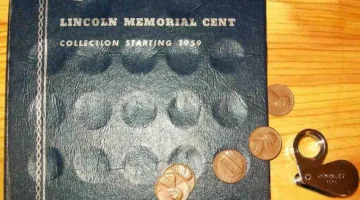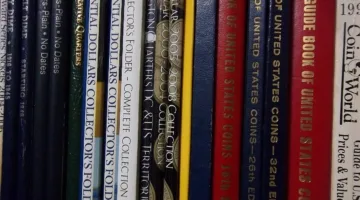Coin collecting is one of the world’s most popular hobbies.
But did you know that within coin collecting there is another pastime that has grown somewhat of a following?
Collecting old coin holders is something many have been doing for years to assemble arrays of obsolete, historic, and retro coin storage.
In more recent years, many coin collectors have looked toward buying old coin holders because they’re often cheaper to buy than new coin holders.
Let’s take a look at some of the old coin holders available to modern coin collectors.
Why Do People Collect Old Coin Holders?

Yes, old coin holders really do have a following.
Here are some reasons people collect old coin holders:
- Nostalgia
- Cost savings
- Coin set theming
- Historical
Another important reason people may collect old coin holders is to find certain types of coin holders for coin sets or coin arrangements that are no longer offered in the modern market.
A Word Of Caution About Old Coin Holders
Warning, warning! Before you start plunging into the world of collecting or using old coin holders, there’s something very important you should know: some old coin holders contain materials that are hazardous to your coins.
Think of it like buying an old house. Homes built during the early 1980s or before may contain hazardous building materials like asbestos or lead paint.
Just as we have learned over the years which materials are dangerous for people (and, through the passage of laws and codes, have since banned the use of these things), numismatists have also gained a knowledge over the years as to which types of materials and environments aren’t safe for coins to be within.
Coins, though made of metal, are really quite sensitive to their environments and, therefore, should be carefully protected.
Many old coin holders contain components like polyvinylchloride (or PVC), sulfur, and glues which pose a very acute threat to coins stored within.
Do your research on each coin holder you use and be careful as to which old coin holders you select to store your coins in!
Old Coin Cabinets
One of the first widely popular ways to store coins was is coin cabinets. Coin cabinets, usually made of wood and consisting of several drawers, can house dozens of coins. Some are quite fancy.
Coin drawers saw their heyday during the 19th century, though as time has drawn on other coin storage methods have evolved.
A few particular drawbacks with coin drawers is that they:
- Are bulky
- Are not airtight
- Can impart slide marks on coins
Old Coin Boards
During the 1930s, a new method of coin storage was invented. Coin boards were widely marketed by Whitman and made a convenient and cheap way to store and display coins.
The introduction of coin boards heralded the widespread collecting of 20th century coins by date and mintmark, such as Lincoln cents and Buffalo nickels.
Coin boards usually consist of one panel with several holes or portals designed for holding a certain arrangement of coins. Coin boards usually range from around 8 inches by 10 inches in size up to about 11 inches by 14 inches and are intended for framing.
While coin boards are manufactured today, finding original or classic coin boards may mean trips to garage sales, flea markets, coin dealers, or a click or two on eBay.
Old Coin Folders

By the 1940s, the advent of the large coin board eventually led to coin folders.
Principally similar to coin boards, coin folders essentially are condensed coin boards that are bound together to form a more conveniently sized foldout book.
Coin folders are what many coin collectors used in the 1940s, 1950s, and 1960s for storing coins — though they continue to be popular today as an efficient way of storing many low-value coins.
Fortunately for coin collectors looking to buy cheap coin folders for their collections, old coin folders are relatively easy to find at many coin dealers and incredibly cheap.
While new coin folders cost anywhere from around $3 to $10, a gently used old coin folder from the 1950s or 1960s can be had for 25 cents to $1.
Old Coin Albums
Coin albums are largely regarded as a classic and (generally) safe way to store large sets of coins.
Often, when coin collectors think about old coin albums, their minds turn to a line of coin albums published by Wayte Raymond. Wayte Raymond coin albums were popular from around the 1930s through the 1960s.
Other manufacturers entered the coin album market as the years went on — including Whitman, Dansco, and Harco.
As mentioned earlier, it’s highly important you carefully scrutinize any old coin albums you purchase for actual coin storage because many old coin albums utilize harmful plastic chemicals that will, over time, damage your coins.
Here’s a video I made that shows one of my Dansco coin albums close-up:
Old Coin Display Cases
Along with the array of coin cabinets, coin folders, and coin albums are the many coin display cases that have been made for decades.
Coin displays — which usually amount to a more luxurious manifestation of the coin board — are among the most expensive types of coin storage you can buy.
The types of coin display cases are also quite diverse, ranging from 3-panel Lucite coin panels to wood clam shell coin cases with velvet lined interiors to hold just one or two special coins.
Old coin display cases range from the cheap to expensive, depending on what type you buy.
As with coin albums, be mindful to avoid any coin display cases that may contain harmful plastics. A little background research on the specific type of coin display you’re thinking about buying should help you get the info you need regarding dangerous materials.
I’m the Coin Editor here at TheFunTimesGuide. My love for coins began when I was 11 years old. I primarily collect and study U.S. coins produced during the 20th century. I’m a member of the American Numismatic Association (ANA) and the Numismatic Literary Guild (NLG) and have won multiple awards from the NLG for my work as a coin journalist. I’m also the editor at the Florida United Numismatists Club (FUN Topics magazine), and author of Images of America: The United States Mint in Philadelphia (a book that explores the colorful history of the Philadelphia Mint). I’ve contributed hundreds of articles for various coin publications including COINage, The Numismatist, Numismatic News, Coin Dealer Newsletter, Coin Values, and CoinWeek. I’ve authored nearly 1,000 articles here at The Fun Times Guide to Coins (many of them with over 50K shares), and I welcome your coin questions in the comments below!

